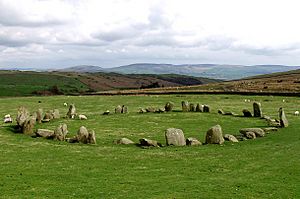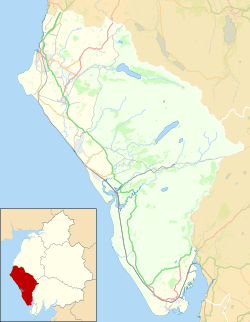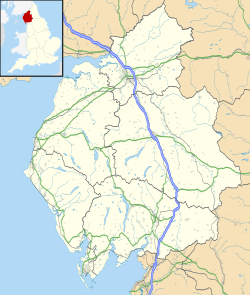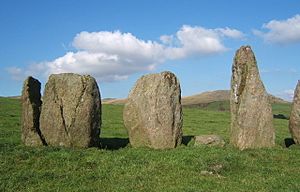Swinside facts for kids

The entire stone circle
|
|
| Location | Cumbria |
|---|---|
| Coordinates | 54°16′57″N 3°16′26″W / 54.2824823°N 3.2738449°W |
| Type | Stone circle |
| History | |
| Periods | Neolithic / Bronze Age |
Swinside, also known as Sunkenkirk, is an ancient stone circle. You can find it next to Swinside Fell, which is part of Black Combe in southern Cumbria, North West England.
This stone circle is one of about 1,300 found across the British Isles. People built it a very long time ago, between 3300 and 900 BC. This period is known as the Late Neolithic and Early Bronze Ages.
The Lake District, where Swinside is located, has many stone circles. Other famous ones include Castlerigg stone circle and Long Meg and Her Daughters. We don't know exactly why these circles were built. However, most experts think they were used for special ceremonies or rituals.
Swinside is made from local slate stones. It measures about 26.8 meters (93 feet 8 inches) across. Today, there are 55 stones, but originally there were probably around 60. It also has a special entrance on its south-eastern side, marked by two larger stones.
In the past, local stories said that the stones were meant for a church. But the Devil kept knocking the church down, and the stones formed the circle instead. Archaeologists started studying Swinside in the early 1900s. They even dug up parts of the site in 1901 to learn more.
Contents
Where is Swinside Located?
The Swinside stone circle is in the south-west part of the Lake District. It is about 8 kilometers (5 miles) north of the town of Millom.
There isn't a visitor center or a car park right at the site. You can only reach it by walking. To get there, you first go to Crag Hall, where you might find limited parking. From there, you walk uphill for about 2.25 kilometers (1.25 miles) on a rough path. The stone circle is to the right of the path, near Swinside Farm.
A famous expert on ancient stone sites, Aubrey Burl, called Swinside "the loveliest of all the circles" in north-western Europe. Another archaeologist, John Waterhouse, said Swinside has a special charm. He felt its beauty was even greater than other famous circles like Castlerigg.
Why Were Stone Circles Built?
"After over a thousand years of early farming, a way of life based on ancestral tombs, forest clearance and settlement expansion came to an end. This was a time of important social changes."
During the Late Neolithic period, British society changed a lot. People stopped constantly expanding into new wild areas. Instead, they focused on settling down and farming the best land. This happened in places like Orkney, eastern Scotland, and the Lake District.
Archaeologists believe that people's religious ideas also changed during this time. Communities stopped building large tombs for the dead. Instead, they started building huge wooden and stone circles.
Aubrey Burl, a leading expert, suggested that this change was important. He thought it meant people's beliefs shifted from darkness to light. They moved from focusing on graves to looking up at the sky and the living world.
What Was Their Purpose?
Archaeologists are still trying to figure out the exact purpose of stone circles. Many ideas have been suggested. Most experts agree that these circles were like outdoor churches or special gathering places.
For example, archaeologist Colin Richards studied stone circles in Orkney, Scotland. He thought they might have been seen as the "center of the world" by the people who built them. Another archaeologist, Aaron Watson, thought this idea could also apply to the huge stone circle at Avebury in southern England.
How Was Swinside Built?
The stones used to build Swinside are a type of slate. They were collected from the nearby hills. Local people in the 1900s called them 'grey cobbles'.
The circle is about 26.8 meters (93 feet 8 inches) wide. It currently has 55 stones, but it probably had around 60 when it was first built.
The builders made a clear entrance on the south-eastern side. This entrance is about 2.1 meters (7 feet) wide. Two large stones were placed outside the main circle to mark this entrance. You can find similar entrances at other stone circles in the Lake District, like Long Meg and Her Daughters. These features are also seen in stone circles in Dumfriesshire, Scotland. Swinside shares many similarities with a circle called the Girdle Stanes.
Local Stories and Legends
Local stories say that the site is called Sunkenkirk because of a legend. People believed that the Devil would pull down the stones of a church being built during the day. As he did this, he created the stone circle instead.
In the 1930s, people in the area also believed that it was impossible to count all the stones in the circle.
How We Learned About Swinside
The first archaeological dig at Swinside happened in 1901. It was led by Charles William Dymond and Collingwood. They dug two trenches, each about 45 centimeters (18 inches) wide. These trenches covered a small part of the inside of the circle.
During their dig, they found a piece of charcoal and a bit of old bone. They also found some modern coins in the top layer of soil.
Images for kids
See also
 In Spanish: Swinside para niños
In Spanish: Swinside para niños






